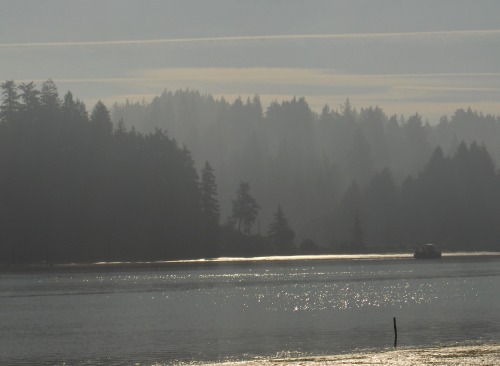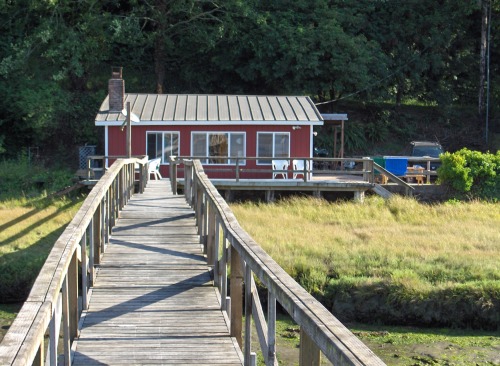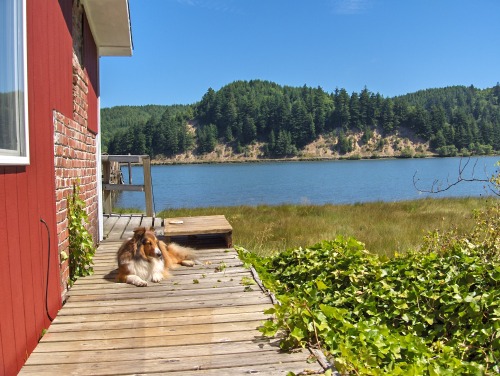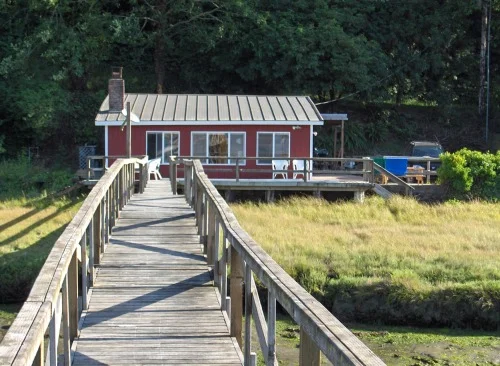Tangled Up in Green
My husband and I have declared war this summer. Not with each other but on the ubiquitous green foliage that threatens to consume our little coastal cabin and the riverbank on which it rests. Embattled Forest Park, in the northwest hills of Portland, has been stricken with the same scourge. So has much of my state.
I’m talking about English Ivy — one of five invasive plant species in Oregon that appear harmless at first, even beautiful, like a feathery yellow wand on a hillside, but that stake their deadly claim on the landscape as far as the eye can see. And don’t let their lyrical names fool you: Star Thistle, Scotch Broom, Himalayan Blackberry, European Beach Grass, English Ivy. They all grow quick as a cancer, vanquishing the natives by strangling or suffocation.
On a paved walking path in my town last week I saw three of the five proliferating away. I even attempted to yank out a solitary Scotch Broom, but already it had put down deep roots, and would not yield. It’s that last member of this lethal tribe now keeping us awake at night, scheming our battle plans — slash and burn? Or choose your poison. So far, nothing seems to work for very long. And our own months of neglect, which we lamely excuse with too-busy lives, offers the ivy boundless time to seize and devour. Unchallenged.

Photo: Mary Van Denend
Our little red stuga lies on a half acre of salt marsh on a tidal river, just where it broadens into a shallow bay that opens up into the wild, blue Pacific. We’re only four miles from the ocean as the crow flies, but since our gravel road dead ends, one must drive 25 minutes to get to the Coast. We like it that way, unhurried, surrounded by shore birds, diving ducks, salmon in their season, boats of all shapes and sizes, and plenty of weather! Just last week a bald eagle perched on a piling not fifty yards away. We’ve seen salmon leap in the air. A resident Great Blue patrols the shoreline out front in search of ghost shrimp. A puttering oyster dredge traverses the river daily, seeding and harvesting.
Our stuga was an old fishing cabin with a sordid history (a drug house, we’re told) that came to us six years ago almost by magic, certainly by grace. The original stone foundation from the ‘30s is all that’s left, so the current place reflects its various owners’ tastes and improvements. Its footprint can’t be more than 700 square feet, a honeycomb of six tiny rooms, all of which I’ve painted in warm, sunny colors and filled with homey, eclectic finds from thrift shops, or borrowed from our main house. A wall of windows faces the water and when the tides are highest, come late December or early January, you swear you’re living on a houseboat. No one would be allowed to build this little haven now, perched on the very edge of these fragile mudflats, making it even more of a transitory gift. We named it RiverWatch, for the endless patterns of wave, light, creature, cloud.

Photo: Mary Van Denend
Pulling English Ivy is back-breaking work. Before you can pull it, you must first untangle it and uproot it, severing the smaller, younger vines from the massive mother vines, which range from thick rope to the size of my forearm. And when you hack your way through them with hatchet or loppers or machete (or a high-powered weed-whacker, which my husband tried last time to no avail) you disturb mats and webs of mosquitoes, roused now from dormancy and ready to strike any exposed spot of flesh.
So, you dress the part: overalls and high rubber boots, windbreakers and thick gloves. A hat of some sort, perhaps a filthy ball cap, which keeps snagging off your head by companion plants, like Himalayan Blackberry. You ache for the sweet release of imprisoned sword ferns and smothered rhododendrons. Lovely on a hot, July 4th weekend, as you glance out to the sparkling river, just as a sailboat glides by, where you can hear people laughing onboard and imagine their smiles, the clink of ice in their glasses.
You look up suddenly at a forty-foot Alder above you and realize the ivy you’ve been pulling for the last two hours is somehow attached to a lasso of ivy cinching the poor tree from its trunk to its upper branches. You are sweaty, thirsty, and exhausted. You use words not part of your common vocabulary. You want to scream. You want to give up. You look back at the sailboat rounding the bend, the stars and stripes flapping in the breeze. WHY are we doing this?
Wendell Berry, that beloved farmer-poet, urges us humans to root ourselves to a particular piece of land, some parcel of the earth where we can learn its ways, know it by heart over a long, long time until it becomes part of us, and we honor that land as our teacher, our metaphor of the Divine. We become a fierce advocate and caretaker in the biblical sense. We don’t simply own a piece of property without considering what grows there, what has been done that needs undoing, how we may reclaim and restore it.
And perhaps most important, what or whom does it border? In the case of our cabin on the river, it borders a pristine estuary, a healthy marine fishery producing oysters for consumers. And beyond that, a whole watershed. As much as we’re tempted, we can’t just spray an annual truckload of Round-Up on the ivy and let that fix the problem. Though a state expert in noxious weed eradication suggests a low dose of that very thing.
My daughter suggests goats. Bring them on! We must find a gentler, if more laborious, solution because we love this river. Every time we pull ivy I’m reminded mightily of the thorns and thistles, the pains of labor, and the sweat of the brow from Genesis. But why can’t the ivy just GO AWAY, find some other forsaken parcel to curse?
In the fall of 2006 my husband started his own business, a manufacturing company to make earth-friendly building blocks out of recycled materials, a full-blown factory from scratch. The product was not some wacky new, untested invention, for it had a long history in Europe, where it originated after WWII. He laid all the right business groundwork: 26 years with an engineering company, a product perfect for the emerging green housing market, and a solid partner with enthusiasm and assets. He embraced the start of his second career with energy and high hopes. We chugged along nicely for almost two years on a steady upward arc, the little company that could.
Then came August 2008 and the crushing economic collapse we now call the Great Recession. None of us could have imagined how the next few years would unfold, how drastically our income would fall, and what mounting struggles we would face just to scrape by. It felt like we were time traveling back to the early days of our 30-year marriage: no frills, no luxuries, just enough to pay the bills. Only the bills were multiplied tenfold, along with our responsibilities to lenders and vendors. We joined the ranks of thousands of other middle-class Americans, asking themselves the same questions: How did this happen? Will we survive? WHY are we doing this?
I often wish money was not a topic of daily conversation in our home. I wish my husband could actually pay himself what he’s worth for his 60+ hours a week. I wish we could travel more, and give more, and not be so anxious. But for all that I wish and all the promising news to the contrary, the recession holds fast, tenacious as the ivy. Yet small signposts of hope do arise, as we hit the half-way mark of 2011. Though the housing market will surely be the last to recover, experts assert, people are starting to think about cottages and backyard studios. A few brave banks are s-l-o-w-l-y making it possible for people to dream again.
A long dormant order suddenly resurrects, or a timely check arrives in the mail. We introduced a second product this spring, a garden bed kit, to help us weather the storm. And so it has.
We have survived. We pray, we persevere. We try to set our sights on pleasures closer to home and remember to delight in daily wonders. We hit the road for trade shows with cheerful names like Good Earth and Better Living, Seattle Home, and Oregon Green Expo. However, fewer people attend these shows than before the recession, and some get cancelled outright for lack of vendors willing to pay the expense of having a booth. Some days I find myself unloading block after block from the back of a diesel pick-up, so we can build a demo wall for would-be customers to see and touch. I offer my thoughts on a feng shui booth design, colors for a new brochure, or edits of web site text. I listen to the ebb and flow of factory stories — you won’t believe what Keith told me today — and ride the roller coaster of promising orders. Like it or not, I am thoroughly entangled in a green revolution I never planned for my life.
When we first bought the cabin I had to pinch myself that it was really ours. It’s a writer’s dreaming place where I have written some of my very best poems. It’s also a place of refuge, which we have shared with grieving friends or family members in need of quiet and solitude. Painted in the classic colors of barn red with white trim, it’s a Scandinavian summer cottage that could live on a cove in Sweden, the pencil pointed firs standing guard across the water. We might as well hang out a sign: “Pippi Longstocking Lives Here.” And just like Pippi’s house, everything’s a bit cockeyed.

Photo: Mary Van Denend
We are trying to be more intentional in how we protect and preserve it, knowing that climate change and rising sea levels could alter everything. Oyster shells may prove our ally in holding back erosion of the river bank — for a time. We come back to the cabin to retreat from the worries of the world and the fears that would plague us. We come to surround ourselves with that “peace of wild things,” as Wendell Berry says. We come to rest and read, cook good food, make love any time we wish, play Scrabble (devilishly competitive), repair what needs repairing, and wage our furious war on English Ivy, practicing caretaking on one small sliver of Eden.



















